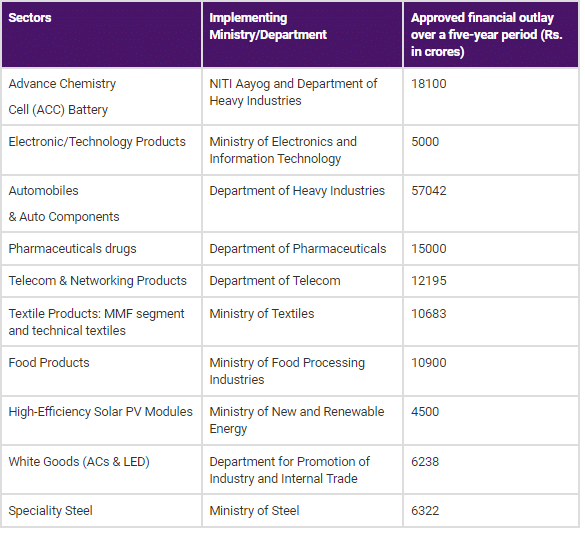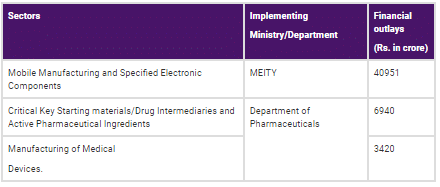PIB Summary- 31st March, 2021 | PIB (Press Information Bureau) Summary - UPSC PDF Download
| Table of contents |

|
| PLI Scheme for Food Processing Industry |

|
| India-Mauritius Comprehensive Economic Cooperation and Partnership Agreement |

|
| All India Survey on Migrant Workers |

|
| AIM-PRIME |

|
PLI Scheme for Food Processing Industry
Context: Cabinet approves Production Linked Incentive Scheme for Food Processing Industry.
Details
- Cabinet approves Production Linked Incentive Scheme for Food Processing Industry to support the creation of global food manufacturing champions commensurate with India’s natural resource endowment and support Indian brands of food products in the international markets.
- The scheme has been launched with an outlay of Rs. 10900 crore.
- It is a Central Sector Scheme.
Objectives of the Scheme
- The objectives of the Scheme are to support food manufacturing entities with stipulated minimum sales and willing to make minimum stipulated investment for expansion of processing capacity and branding abroad to incentivise emergence of strong Indian brands.
- It aims to:
- Support creation of global food manufacturing champions;
- Strengthen select Indian brands of food products for global visibility and wider acceptance in the international markets;
- Increase employment opportunities of off-farm jobs; and
- Ensuring remunerative prices of farm produce and higher income to farmers.
Features
- The first component relates to incentivising manufacturing of four major food product segments viz. Ready to Cook/Ready to Eat (RTC/ RTE) foods, Processed Fruits & Vegetables, Marine Products, Mozzarella Cheese.
- Innovative/Organic products of SMEs including Free Range -Eggs, Poultry Meat, Egg Products in these segments are also covered under above component.
PLI Scheme – A Brief Background
- It was introduced as a part of the National Policy on Electronics by the IT Ministry to give incentives of 4-6% to electronic companies, manufacturing electronic components like mobile phones, transistors, diodes, etc.
- The main aim of this scheme was to invite foreign investors to set up their manufacturing units in India and also promote the local manufacturers to expand their units and generate employment
- The first sector which the PLI scheme had targeted was the Large Scale Electronics Manufacturing in April 2020, and by the end of the year (November 2020), 10 more sectors including food processing, telecom, electronics, textiles, speciality steel, automobiles and auto components, solar photovoltaic modules and white goods such as air conditioners and LEDs were also expanded under the PLI scheme
- As far as the eligibility is concerned, all electronic manufacturing companies which are either Indian or have a registered unit in India will be eligible to apply for the scheme
- In the Union Budget 2021, Finance Minister Nirmala Sitharaman mentioned the inclusion of thirteen more sectors under the PLI Scheme for a period of five years and Rs. 1.97 lakh crores have been allocated for this scheme from Financial Year 2022
Expansion of Production Linked Incentive Scheme
- The Union Cabinet chaired by Prime Minister Narendra Modi, on November 11, 2020, approved the introduction of the PLI scheme for the 10 key sectors which can enhance India’s Manufacturing Capabilities and improve exports.
Given below are the 10 new sectors to which the scheme has been expanded along with the approved financial outlay:

Based on the ten sectors to which the Production Linked Incentive scheme was expanded to, the government aims at achieving the following targets:
- The government aims to make India an integral part of the global supply chain and enhance exports
- India is expected to have a USD 1 trillion digital economy by 2025 as it expects the demand for electronics to increase under its projects like Smart City and Digital India
- The PLI scheme will make the Indian automotive Industry more competitive and will enhance the globalisation of the Indian automotive sector
- The Indian Textile Industry is one of the largest in the world and with this scheme, it shall attract large investment in the sector to further boost domestic manufacturing, especially in the manmade fibre (MMF) segment and technical textiles
- India, being the second-largest producer of steel in the world, introducing it under the PLI scheme will benefit the country as it may expand export opportunities
- Similarly, telecom, solar panels, pharmaceuticals, white goods, and all the other sectors introduced can contribute to the economic growth of the country and make India a manufacturing hub globally
Production Linked Incentive Scheme for Large Scale Electronics Manufacturing
- The first phase of the PLI scheme was dedicated to the Large Scale Electronics Manufacturing sector and the scheme proposed to increase the manufacturing of mobile phones in India along with setting up their Assembly, Testing, Marking and Packaging (ATMP) units
- The total cost proposed for the scheme was INR 40,995 crore
- It was set up to benefit a few global investors and mainly the domestic manufacturers in India
- With high potential for employment generation, the scheme can help employee over 2 lakh people in 5 years in the electronics manufacturing sector
- Till date, in the case of electronics, the assembling of objects was done in India, while the production was done outside. With the PLI scheme and Make in India campaign, the electronics can be made ad assembled in the domestic industries itself
- The production of mobile phones in the country has gone up significantly from around INR 18,900 crore in 2014-15 to INR 1,70,000 crore in 2018-19 and the domestic demand is almost completely being met out of domestic production. With PLI, this can be increased even further
The table given below shows the financial outlay as per the first phase of the Production Linked Incentive (PLI) Scheme:

Production Linked Incentive Scheme for Pharmaceuticals
- PLI scheme for Pharmaceuticals was introduced for a period of five years between FY 2020-21 to 2028-29. Total incremental sales of Rs.2,94,000 crore and total incremental exports of Rs.1,96,000 crore are estimated during six years from 2022-23 to 2027-28
- The scheme is expected to generate employment for both skilled and unskilled personnel, estimated at 20,000 direct and 80,000 indirect jobs as a result of growth in the sector
- The duration of the scheme will be from FY 2020-21 to FY 2028-29. This will include the period for processing of applications (FY 2020-21), an optional gestation period of one year (FY 2021-22), an incentive for 6 years and FY 2028-29 for disbursal of incentive for sales of FY 2027-28
India-Mauritius Comprehensive Economic Cooperation and Partnership Agreement
Context: India-Mauritius Comprehensive Economic Cooperation and Partnership Agreement (CECPA) will enter into force on 1st April 2021.
Details
- The CECPA between India and Mauritius was signed in February 2021.
- It is the first trade agreement signed by India with a country in Africa.
- The Agreement is a limited agreement, which will cover Trade in Goods, Rules of Origin, Trade in Services, Technical Barriers to Trade (TBT), Sanitary and Phytosanitary (SPS) measures, Dispute Settlement, Movement of Natural Persons, Telecom, Financial services, Customs Procedures and Cooperation in other Areas.
- The India-Mauritius CECPA provides for an institutional mechanism to encourage and improve trade between the two countries.
All India Survey on Migrant Workers
Context: Labour Minister flags off Field Work of All India Survey on Migrant Workers and the AQEES.
Details
- These are two of the five All India Surveys that the Labour Bureau is going to conduct this year.
- AQEES is one of the surveys: All-India Quarterly Establishment based Employment Survey
- Labour Bureau, Chandigarh organised the Training of Trainers for the five All India Surveys relating to Domestic Workers, Migrant Workers, Employment Generated by the Professionals, the Employment Generated in Transport Sector and the All India Quarterly Establishment based Employment Survey.
- The back-to-back training sessions were a part of the three-day comprehensive training sessions to be imparted to the officers/officials of the Labour Bureau, the officers from the seven regional offices of the Labour Bureau and the officials from various state governments.
- These trainings are a precursor to the trainings that will eventually be imparted to the field officers who will ultimately undertake the surveys across the country.
About the Five All India Surveys
- The Labour Bureau is all set to launch its five major surveys, including on migrant and domestic workers, across the country by April 1.
- The surveys that would be conducted are:
- All-India Survey on Domestic Workers (DW): to estimate the proportion of DW in the workforce by major states and across India and percentage distribution of these DWs/households that employ them by important socio-demographic key characteristics.
- All-India Survey on Migrant Workers: to find the estimated number of migrant workers in India and also collect information on their living conditions, working conditions and other socio-economic conditions.
- All-India Survey on Employment Generated by Professionals: firstly, to estimate the total number of active professionals in the country and secondly, to capture the employment generated by these professionals.
- All-India Survey on Employment Generated in Transport Sector: to assess the number of jobs generated in the transport sector in the country.
- All-India Quarterly Establishment based Employment Survey: to measure relative change in employment situation over successive quarters in a sizeable segment of the non-farm economy covering eight important sectors of the Indian economy.
- The results of these surveys will be declared within seven to eight months, including six months field work.
About the Labour Bureau
- It is an attached office of the Ministry of Labour & Employment and has been at the forefront in fulfilling the data needs of various stakeholders in the field of labour and employment since 1920.
- The two main wings of the bureau are in Shimla and Chandigarh.
- It has four regional offices in Ahmedabad, Chennai, Kanpur and Kolkata and a subregional office in Mumbai.
- The organisation is headed by a Director General, a Higher Administrative Grade Officer from the Indian Economic Service (IES). He is assisted by a team of dedicated professionals from the Indian Economic Service and the Indian Statistical Service.
AIM-PRIME
Context: Atal Innovation Mission launches ‘AIM-PRIME’, in partnership with BMGF & Venture Center.
Details
- AIM-PRIME (Program for Researchers on Innovations, Market-Readiness & Entrepreneurship) is an initiative to promote and support science-based deep-tech startups & ventures across India.
- It has been launched by the Atal Innovation Mission (AIM) in partnership with the Bill & Melinda Gates Foundation (BMGF). The initiative will be implemented by Venture Center – a non-profit technology business incubator.
- The first cohort of the program is open to technology developers (early-stage deep tech start-ups, and scientists/engineers/clinicians) with strong science-based deep tech business ideas. The program is also open to CEOs and senior incubation managers of AIM Funded Atal Incubation Centres that are supporting deep tech entrepreneurs.
- The AIM-PRIME program is specifically tailored for the rapid scaling up of deep-tech science ventures in India, providing not just the necessary intellect and support but also the exposure they rightly deserve.
Program Benefits
- The benefits of this program are aimed at addressing specific issues through training and guidance over a period of 12 months.
- Candidates selected for the program will get access to in-depth learning via a comprehensive lecture series, live team projects, exercises, and project-specific mentoring.
- They will also have access to a deep tech startup playbook, curated video library, and plenty of peer-to-peer learning opportunities.

|
Explore Courses for UPSC exam
|

|

















